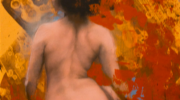In early June, the Chronicle/SF Gate devoted a few miles of HTML to an article about the “G-Shot”. This is a new procedure where women who feel (or are convinced they feel) G-Spot inadequacy, have a shot of collagen injected into their urethra. The idea behind the G-Shot is ostensibly to swell up the urethral opening and canal and heighten sensitivity. It was invented (and trademarked) in 2005 by Dr. David Matlock, a Los Angeles gynecologist and plastic surgeon (he now sells G-Shot kits to colleagues and recently opened the Laser Vaginal Rejuvenation Institute of America in Los Angeles).
Re-cross your legs, and chill with me for a minute. Now, historically, people have done, and still do, some seriously wacked things to their bits in order to have better, more intense, funner crazier sex. Guys shoot themselves with caverject to maintain erections on porn sets; they also get silicone injections to add size. Women get their pussies tightened by plastic surgery docs more and more, and less than a hundred years ago gals underwent bizarre mechanical medical procedures for “female hysteria”, not to mention the Spanish Inquisition-style devices doctors once recommended to prevent masturbation.
You really haven’t come a long way, baby. But have you come, lately? The real questions I have about the G-Shot, once I get past my visions of guys with questionable sexual pleasure knowledge hovering over vaginally insecure ladies with three-and-a-half-inch needles are simple. Does it work, or not? Is there any long term-damage to sexual function? Do the docs explain everything before they shoot?
(And now my embattled Chronicle editor moans.) Sadly, the SF Gate piece suffered from a certain typical sex journalism malaise; it was not sex-negative, for a change, but the author began the piece setting us all in doubt as to whether the G-Spot exists at all. The actual sex information about the topic (the G-Spot) was entirely missing from the piece — and later when the procedure is described, it’s totally, utterly confusing as to what’s even going on when the shot is administered. The writer totally danced around the G-Spot’s anatomy, which required an explanation. I mean, seriously — the vagina ceased to be a dark mystery cave like 40 years ago. Was it the writer’s distaste or ignorance? Or is it because the fundamentals of mainstream sex reporting rely on consumers (readers, customers) having the same level of sexual confusion as the women getting the shots, or the men administering them?
The women getting shots, and things like vaginal rejuvination (plastic surgery) are facing some serious issues, which I would love to see explored in any article about the G-Shot. Is anyone devoting time to finding out what these issues are, and what the docs think about them? I mean hey — even famous porn stars have vaginal plastic surgery disasters.
I’d love to see these things (like the G-Shot) reported on by someone with sexual knowledge. Also: even-handedness with pros and cons. The article asked the question “does it work?” but didn’t ask “how does it fail?” though this may be attributed to the writer’s sex knowledge limitations preventing them from knowing what questions to ask. (Keep in mind I’m not in judgment of women making their pussies into Franken-gasm machines if they so desire, as long as they’re informed.)
So, here’s a snip from Enhanced romance: The G-Shot — Is it the latest panacea to improve your love life?:
Karen Roberts scheduled an appointment with her plastic surgeon at the end of a long day. The 22-year-old student at Solano Community College attended morning classes, caught up with homework and took her 4-year-old daughter to a matinee.
By 4 p.m. she sat inside Dr. Justin Salerno’s office, readying to become the surgeon’s first patient to receive an injection called a G-Shot, also known as G-spot Amplification. With a 3 1/2-inch needle, Salerno would pump a small dose of collagen into his patient’s Grafenberg Spot and make it swell to the size of a quarter.
The G-spot has been the subject of lore and controversy since it was first identified in 1950 by the German gynecologist Ernst Gräfenberg. Some sexologists believe the small area behind the pubic bone and accessible through the anterior wall of the vagina is an erogenous zone that when stimulated leads to heightened sexual arousal and powerful orgasms. Others dispute the zone’s very existence, arguing that studies have turned up no scientific evidence of the G-spot’s location, or only highly questionable results.
In the case of Roberts (a pseudonym used at her request to protect her privacy), she was unsure whether the G-spot existed, and if it truly held the key to a vibrant sex life. But she was willing to find out.
“If I could come home like my husband, have sex and feel that release,” Roberts said before her appointment, “I’d be one happy woman. But instead I come home, I spend all this time concentrating, hoping something will happen and I just end up frustrated.”
The procedure, which has been performed on approximately 250 women nationally in the past two years at a cost of $1,850 each, appealed to Roberts because she felt life’s rigmarole had left her fatigued by the end of the day, hardly in an amorous mood. Even when she felt the surge of excitement, reaching an orgasm was a time-consuming endeavor that took more effort and energy than she and her husband had to offer.
Link.
Now, dig the response in Sound Off about the G-Shot from someone with practical sexual pleasure knowledge, Dr. Carol Queen:
To be sure, there are some women and men who suffer from true sexual dysfunction, who need and could really use pharmaceutical or other medical help.
But most people with sexual issues do not fall into this category. Most people who are unhappy with their sex lives have partners with whom they are incompatible in some way, or they (and their partners) suffer from insufficient or incorrect information about sexual arousal, pleasure and functioning.Plus, Americans harbor the “Fix it, Doctor” belief that a visit to the physician can and will cure what ails them, even if “what ails ’em” is not, in fact, an ailment at all.
The real problem with innovations like the “G-Shot” is not that they might not work, though news coverage like the San Francisco Chronicle’s recent article about the procedure devoted scant ink to that possibility.
The real problem is that these Next Big Sex Things obscure the role of good, old-fashioned sexual and anatomical knowledge and the ability of partners to communicate about what they like, what they want, and what works best to arouse and satisfy. They also obscure the fact that different people may best be pleased by different things. That’s because, simply, everyone is not alike.
But then, why would a plastic surgeon devote any time at all to explaining this? There’s no money in that for him, as there assuredly is for doing the “G-Shot” and the next procedure and the next.
Just as most MDs don’t take the time to look up from writing a prescription for Viagra to say “Oh, by the way, if you simply cut out fatty foods and nicotine, cut down on alcohol, and walk twenty minutes every day, you probably wouldn’t need this stuff.”
If most of the new breed of “G-Shot” docs won’t take the time to tell their female patients the basic information needed to succeed at sex, who will?
Link.
Now, I’ll do the thing no one else here has — explain G-Spot anatomy. Read it in an excerpt from The Smart Girl’s Guide to the G-Spot, after the jump.
Excerpt, chapter 1: The Smart Girl’s Guide to the G-Spot:
Plainly put, the g-spot is an area just inside your vagina, that when you’re turned on, might feel really good to rub or massage. It might even feel so good you have an orgasm from that type of stimulation alone. About 1-2 inches inside and on the front (bellybutton side) of your vaginal canal is where urine leaves your body — your urethra. The urethra is a little channel between your bladder and the outside world, and it’s surrounded with erectile tissue (like in a penis) and about 40 glands and ducts that all respond pleasurably to stimulation. Sometimes it’s the urethra, or the area right around it, that feels the best to stimulate. That’s it — and in later chapters I’ll explain exactly what everything is, precisely how to locate it, how to touch the area and what it should feel like and much more.
Excerpt, chapter 2: The Smart Girl’s Guide to the G-Spot:
(…)
The area of the clitoris is far larger than described in conventional anatomy texts and most sex guides. The external tip, or glans, is really the tip of the iceberg — and if you know icebergs, they’re like upside-down pyramids and this is a perfect analogy. The glans begins at the tip of the shaft and continues under the surface to where the other end connects to the suspensory ligament at the pubic mound. You can feel this connection between your clit and the pubic bone by rolling your finger across the area; it feels somewhat like a soda straw (and feels firmer when you’re aroused). The shaft, like the glans, is very sensitive and responds pleasurably to stimulation. At the shaft’s connection to your pubic bone, the clitoris runs underneath both sides of your vulva alongside the vaginal opening in a wishbone shape, forming two legs, or crura, and extends all the way to your perineum.
The internal area occupied by the clitoris and crura is actually a complex clitoral system, wrapped in erectile tissue — just like the stuff that fills with blood during arousal to make a penis hard. The connecting nerves, tissues, muscles, and ligaments all react and engage with one another during your arousal cycle. And guess what? Your g-spot has the princess seat right in the middle of all this. The clitoral area underneath the inner and outer lips, the ring around the urethra (where urine leaves the body; g-spot), and the wall of the perineum all contain erectile tissues that fill with blood and swell upon arousal — sometimes noticeably, sometimes not. Several layers of muscles line the pelvic floor, connecting the clitoris to these erectile tissues. An oval-shaped muscle of erectile tissue surrounds the inner lips and clitoris, where the vagina and g-spot pass through it, and connects to another oval that surrounds the anal sphincter muscle, encircling the anus.
(…)
Both women and men have an identical ring of spongy erectile tissue surrounding the urethra (where urine leaves the body). It is an essential part of the clitoral system and your entire orgasmic network, and even when you simply jack off through clitoral stimulation, your g-spot participates in the orgasm (but more on that in the next chapter). Located inside the vagina, the urethra is a tube that’s roughly two inches long, running from the bladder to the urethral opening on your vaginal wall. This ring of urethral tissue is the outer area that shows you where your g-spot is.
The urethral sponge is located on the front wall of the vagina, toward the belly button; if you’re lying on your back, it’s the “top” of the vaginal wall. From the vaginal opening, it’s roughly one or two inches inside. The outer area is the marker to let you know where the g-spot actually begins, because there’s a lot more of it beneath the surface. In addition to the two inch long urethral canal leading to the bladder, there is a whole lot more surrounding the urethral opening (and sponge) that makes up the entirety of the g-spot, and it all responds to g-spot stimulation; to enjoy your spot and come, you’ll be touching not just the urethral opening but the area surrounding it as well.
The spongy tissues that surround your urethra and comprise your g-spot are a complex bundle of — joy! Along with the erectile tissue, you’ve also got the nerve-rich urethra itself and about 40 super-tiny glands and ducts (called paraurethral glands, or Skene’s Glands) that respond to arousal and pleasure. Sometimes, and in some women, stimulation of the g-spot to orgasm can result in an expulsion of fluid form the urethral sponge — this is female ejaculation (detailed in chapter 5, “Wet Spots: Ejaculation”), and the paraurethral glands and ducts have the starring role in that particular wet, wonderful show. The purpose of the urethra is certainly to have a river run through it, but everything else prefers to play by the same rules as your clitoris: just for fun, thanks.
How to Get There From Here
Want to feel it? One way is to stop a stream of urine, mid-flow. Doing this, you’re flexing your PC muscles (the sling of pelvic muscles that engage during orgasm) and putting acute pressure on your g-spot to flex. Another way to investigate the g-spot is with your fingers — putting a finger or two just inside your vagina and stroking the front wall. You’ll have to curl your hand around a bit to get your fingertip to stroke the front wall, so sitting down on a stool or hard chair might make it easier for you to spread your legs, push your pelvis forward, and feel. I highly recommend using a water- or silicone-based lubricant in your explorations, as slick surfaces are easier to detect under your fingertips. I recommend a variety of excellent lubricants for g-spot exploration in chapter 3, “Turn It On, Turn It Up”.
What you’re feeling for is a soft bump or slight change in the surface of your vaginal wall. If you touch yourself just inside your vagina, you’ll notice that the surface near the opening is slightly furrowed with subtle ridges, and a bit more so in the area where you’ll be concentrating your search for the urethral opening. It’s interesting to note that this ridgy outer area of the vaginal canal (about the inner 1/3) is most sensitive to touch, vibration and more subtle textures and shapes than the smooth-walled inner part, which cares less about vibration and responds pleasurably to sensations like fullness, rhythm and thrusting (the inner 2/3). If you’re feeling like exploring, touch and press all around your urethral opening while squeezing your vaginal muscles and see if you can feel what’s beneath the surface.
If you’re unaroused, the urethral sponge is relaxed and might be difficult to feel. But during arousal, your sponge swells and hardens, and it becomes more obvious to touch. Touching it in an unaroused state might feel strange, like you have to pee a bit, or it might be too sensitive to touch — or it might feel good. It might even feel really good. You may find that touching it turns you on a little, and that once your g-spot is firm with arousal, massage and vibration are delightful. Just try a simple touch once, and see what you think.





